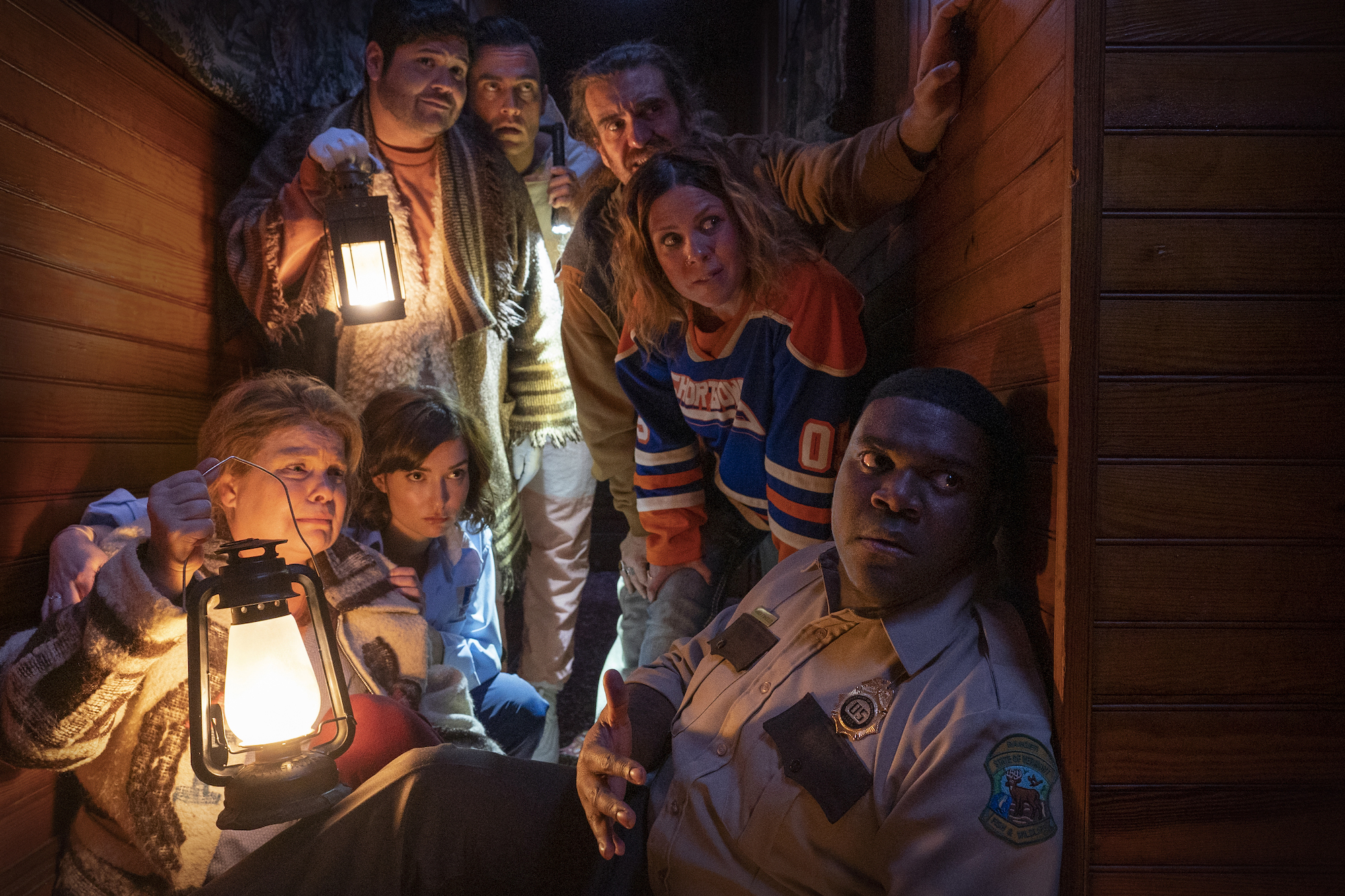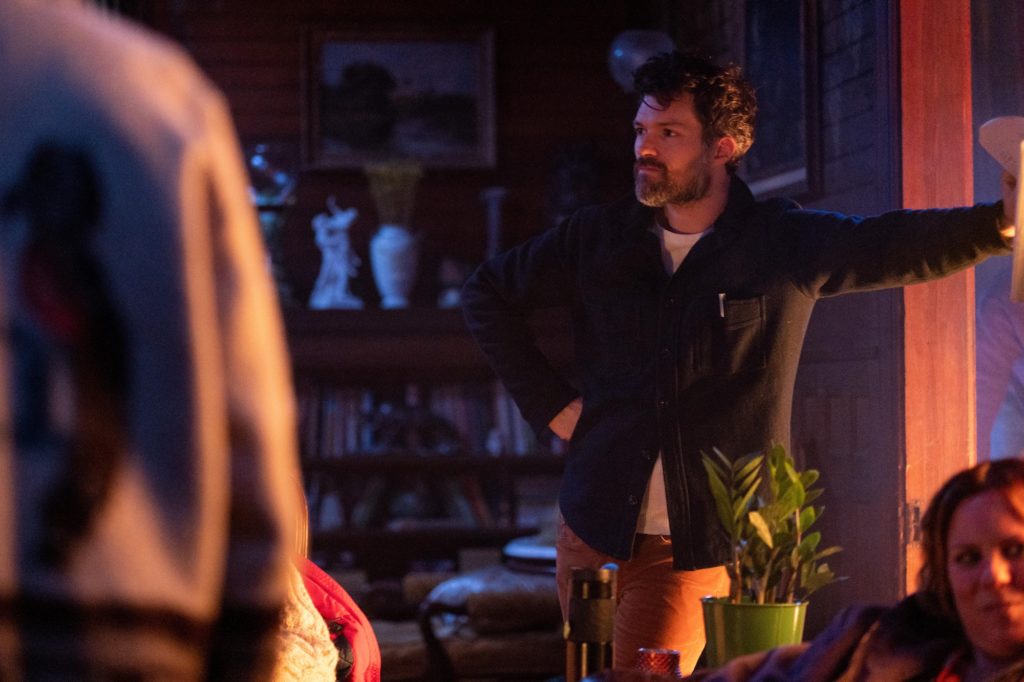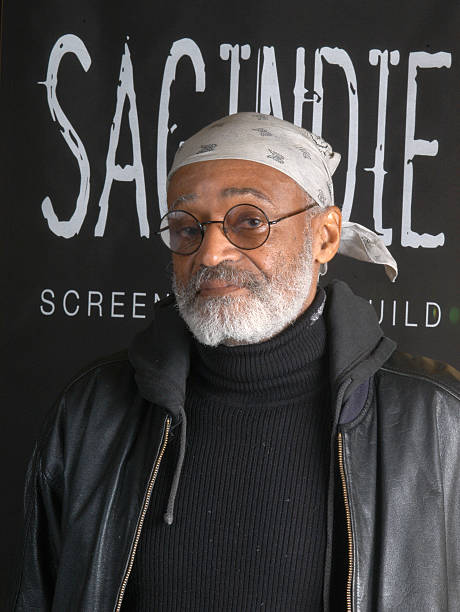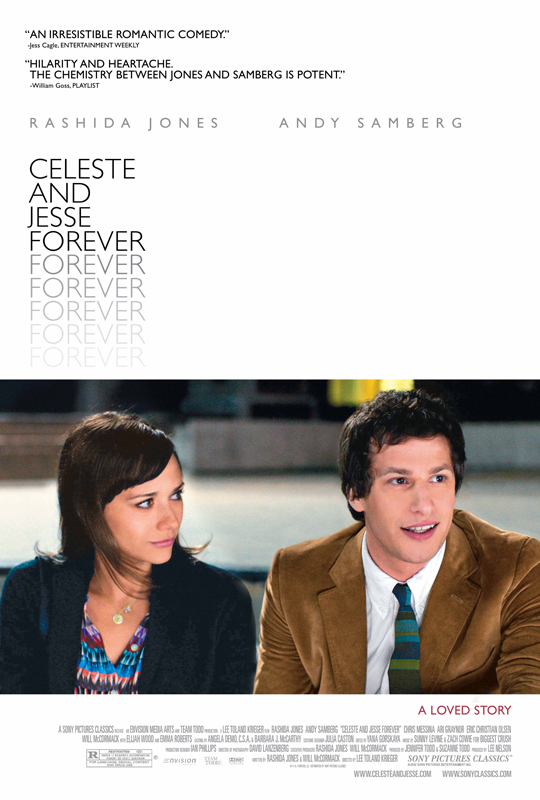If you watched any comedy on the internet from roughly 2003 to the present, you’ve likely encountered a JOSH RUBEN production. From his early online sketch group Dutch West to the Upright Citizens Brigade to being a founding member of CollegeHumor Originals, Ruben spun his “content creator” experience into a stable filmmaking career, directing TV variety segments (The Late Show with James Corden; Adam Ruins Everything), commercials (Geico; TurboTax), and podcasts (Funny or Die & Spotify’s The Last Degree of Kevin Bacon). As an actor, he’s shown up in indie features including For a Good Time Call…, Unlovable, Greener Grass, and Plan B. In 2020, he starred in his feature directorial debut Scare Me (which he also wrote and produced), a horror-comedy that premiered at the 2020 Sundance Film Festival. On the heels of Scare Me‘s premiere, Ruben quickly got to work on his second directorial feature, WEREWOLVES WITHIN.
Based on the Ubisoft video game with a script by Mishna Wolff, Werewolves Within finds a forest ranger (Sam Richardson) reporting for duty in the sleepy mountain town of Beaverfield, Vermont. As he meets the local oddballs (played by an ensemble cast including Milana Vayntrub, Michael Chernus, Catherine Curtin, Harvey Guillén, Cheyenne Jackson, Michaela Watkins, and Glenn Fleshler), he soon realizes the town may be under attack by a lycanthrope (aka werewolf). IFC Films will release the horror-comedy whodunit in theaters on June 25, and on Digital Rental and VOD on July 2, 2021.
We spoke to the film’s director Josh Ruben to talk about his career and his new project, Werewolves Within.
——
COLIN McCORMACK: You started in internet comedy – the early days of CollegeHumor, YouTube, and Vimeo. At that time there wasn’t really a set template on how to transition from being an “internet person” to a career in filmmaking. How did you navigate that path from where you started to where you are now?
JOSH RUBEN: That’s a great question. It began with realizing that no one was going to spoon-feed me, which I realized both at the beginning of my career and in the middle before I did Scare Me. No one was going to spoon-feed me an agent when I was a teenager and in my early twenties, so I decided I’d make videos with my friends. And I realized no one is going to spoon-feed me the opportunity to make a movie in my early- to mid-thirties, so I had to do it myself. Navigating it had everything to do with finding my tribe, finding my buddies, finding my fellow weirdos to make stuff with. [It was] a combination of people I met at summer theatre camp – Sam Reich and Elaine Carroll, his brilliant wife – and then buddies I linked up with through acting school and otherwise that I grew up with. It just becomes about continuing to find those like-minded people that you trust and that trust you, that you’re a fan of and are a fan of you. That begins everything and it spans the spectrum beyond filmmaking too. It’s pretty much everything, finding your community, right? From there, that’s how I’ve been able to find any modicum of success.
CM: Since you’re an actor, writer, producer, and director, how do you balance what projects you want to pursue and in what capacity? Is it planned out where you think, “This month I want to write something,” or “This month I want to be auditioning more,” or do you just take opportunities as they come?
JR: It’s a combo. I take stuff as they come. When I go into survival mode – like when there’s truly nothing going on, which definitely happened during the ol’ pandemmy – that was an opportunity to go, Okay I think it’s time to start writing a script again. And there’s always something different. I just popped out a draft of a really stylish sort of slasher [script] intended for my fiancée to direct – she’s a badass music video director. That’s a world I’d love to get into. Noah Segan, who’s a brilliant actor who has worked with Rian Johnson pretty much since the beginning of his career, came to me and said, “I want to do what you did with Scare Me. Would you like to produce my triple-threat feature?” I said, “Hell yeah! Why not?” Just taking those kinds of opportunities as they come that sound fun. And then if a gig as massive as pitching on Werewolves Within and a $6.5 million movie comes along, especially after your first one, you’ve gotta at least read the script despite that spooky prerequisite of “video game adaptation,” which made my shoulders go up and probably all my actors’ shoulders as well. I go, “Oh gosh, a video game movie called Werewolves Within?” But when you open the script and see that Mishna might be one of your tribe and writes like you want to write, that you aspire to write and work with, you’ve got to follow those opportunities as they come.
CM: Speaking of the pandemic, I feel like that was the moment where every filmmaker had to operate like a person making their first film. Scare Me has a lot of those hallmarks of a limited location and very few characters. Obviously, you made that pre-pandemic, but what were some of the core lessons you learned making that that you could apply once you tackled the bigger project with the bigger budget?
JR: Definitely that a film is a living, breathing organism; that it’s going to change from the first moment you see that first cut to the end. I saw the first cut of Scare Me – Patrick Lawrence, my editor, showed me – it was two hours and fifteen minutes and I said, “Oh, this is brilliant. I can’t believe it works so well.” And he’s like, “You’re going to have to cut at least a half-hour from this, bro.” So learning that when you walk away from it – just like with a script – two days later you’ll revisit and go, “Ohh, yeah. There’s a whole lot I’m noticing now that I’d love to nix, that we can pare down.” That keeps happening and remains to be the case after you’re told that you’re done. There’s always more that you’d like to go back in and trim and tweak. The other thing is communication. I always knew that communication was an integral part of the process, but having conversations with Aya Cash and Chris Redd and Becky Drysdale on Scare Me, “How do you like to work?” “How do you like to be directed?” “What do you need from me?” Especially if I’m acting opposite you, I know I need to be prepped as all hell for that, more than anything else, so I can be a good partner. Keeping communication at the absolute forefront and treating my actors the way I always wanted to be treated by a director, having my hand held just a bit until they say, “Please stop holding my hand, I’m good,” I think is an important lesson I’ve learned or taken from that first one.
CM: What was the decision to not act in Werewolves Within like you did in Scare Me?
JR: It was a few things. It was the biggest gig I’d done; it was a massive responsibility. I would probably be crazy intimidated acting opposite the likes of Glenn Fleshler and even friends like George [Basil] and Milana. But I’ve scratched the itch, you know? Mark Duplass talks about this with Creep. Like, there are probably some things I could do where I could make pretty interesting choices and I would be pretty good for the “X white dude thirtysomething” part or whatever, but I’m more interested in working with people who haven’t necessarily gotten the opportunity to play certain parts and putting them in front of the camera and championing them and then maybe cameoing in a funny nose to raise them up if that’s what it ends up being. But I’m more interested in the latter, for sure.
CM: Werewolves Within is based on a video game. Once you signed on, were you looking to the game for visual cues, or was the script based on the game and once the script was done, that was its own entity and the video game was no longer the focus?
JR: It’s funny, the video game was so – I don’t want to say “moot” – but Mishna developed the script with Margaret Boykin and Jason [Altman] at Ubisoft through their women’s film and TV fellowship program. Their mandate to her was just to pick an IP that you like that you think there might be a story and just blow it open any way you want, and she did. So the only thing we owed Ubisoft – that we owed anyone, in the end – was a good movie. They just said, “Make a good movie. Make it something people want to see and bring their friends to.” And that was very freeing. I didn’t owe Easter eggs, but I did still print out screenshots of the game and say, If there’s a world where we can bring in this shade of purple, this warm light. There’s a table – I’m just kind of realizing this since it’s been a while since we wrapped – there’s this table in the video game that is cut from a tree stump from a giant old tree, and Lauren Crawford and my production design team had found a table very similar to the one in the game. So I could at least, for those who played it, be able to point out that you can see the ledger in the lobby is like the game book, you can see that the table is like the table in the game that all the characters are gathered around, and some of the lighting. So the spirit is definitely there. I wouldn’t make an adaptation of anything without an Easter egg because that as an audience member is what I love. I love to be able to go, “Oh, that’s for me!”
CM: You had this huge cast and I’m sure it was no easy feat to make all the schedules align and get everybody out to location. How early in the process did you start casting people? And how late was the latest person added to the mix?
JR: Oh man, late was real late. I want to say Glenn Fleshler was the last one in, maybe two weeks out before we had to get him in front of the camera. Let’s see, if we shot in February I want to say we started definitely in December, maybe even late-October or November of 2019, having those conversations and getting deals going and long-forms and all that stuff. It takes forever. I think Sam we locked in right before the holidays, which was a real big deal. We didn’t have our lead solidified and we all wanted Sam and were all like, Oh God, is this going to work? It was a wonderful process, though. I started with my friends. George Basil, I said, “I know I want George there because he’s my friend and I’ll be able to get a hug at the end of the day if all goes to shit.” And Milana, same thing. I’ve known her for eons and she’s so popular and has this massive following and is a comedic genius. She should have this opportunity, she deserves it. Oh my God, I hope she takes it. Yeah, probably early October we started getting the thing rolling with [casting director] Gayle Keller and her team.
CM: A lot of your cast have improv experience. Was there anyone who really flipped the character on their head from how they were originally written? Or everybody is giving their own spin on what was built in the script?
JR: Everyone certainly gave their own spin to a degree, more or less. They’re so straightforward on the page, everything becomes about the jazz you let your actors play and the freedom you give them. Milana brought even more buoyancy and charm. Sam brought even more buoyancy and humanity and warmth to Finn than I had even thought possible. But Rebecca Henderson really surprised us. That role was written for like a Richard Jenkins type. And I would have been thrilled to have a Richard Jenkins in this character role, but we’d sort of seen it. So I thought, Why not Rebecca? Why not a woman scientist? Give someone like Rebecca the opportunity to play this meltdown. She’s a buddy and such a damn genius and it was like, Yeah, this is going to be fun casting, let’s go for it. And I’m so thrilled that we did. She has some of my favorite lines.

CM: In the “whodunnit” format, obviously a big cast of suspects is important, but also the location is hugely important. Where did you shoot and how did you end up finding that town – or those towns – that together made [Beaverfield]?
JR: I would like to make the Hudson Valley [New York], for me, what Pennsylvania is for M. Night Shyamalan. He always goes back – I guess with the exception of Old, his new movie. But I love the Hudson Valley, I think it’s so inspiring. I grew up here, I was terrified of the woods here, I watched great movies here, I made great friends here, I played here and dreamt here and wrote here and read here. I love this area and I knew I wanted to shoot in the Hudson Valley again – I did it with Scare Me. And my fiancée was the one to suggest Spillian. She had stayed there for a New Year’s party a few years ago. You want a place like the Beaverfield Inn to feel like a character the moment you walk in, and [Spillian] felt like a parlor in Clue, with the ballroom and the cafe and the labyrinthine hallways and dark corners. It felt perfect and we knew we had to go. To be able to hunker down at Fleischmanns and at Spillian and shoot at Woodstock Film Stages, where I shot the musical sequences in Scare Me where all we could afford was to create a black curtain void for the musical sequence. Then to go back and build this entire bar and The Axe Den to shoot in downtown Phoenicia, meant the world to me. That’s a big reason I pitched on the film. This script speaks to me, I’m a kid who grew up in a town like Beaverfield. I see it in my Beaverfield, which is the confluence of these towns.
CM: So the big inn, the exterior and interior were actually the same location?
JR: Yeah. It’s funny, there’s this wonderful young couple who have Tweeted at me, “We’re having our wedding at the Werewolves place!” And I ran into them. We did an advance screening of Werewolves Within at the Greenfield Drive-In in Greenfield, New York, last night and that couple was there and the [Spillian] owners Mark and Leigh were there to all say, “Holy crap, you’re having a wedding there.” They said, “Keep it coming!” If I can bring commerce to Fleischmanns, New York, and any part of the Hudson Valley, to my home, that’s the dream. I just want to keep shooting here.
CM: The film premiered last week, I think, at Tribeca?
JB: On the sixteenth, yeah.
CM: Were you able to go in person?
JB: I did. It’s crazy, they toss this stuff at you last minute. Because I’d only gotten to see Scare Me once at Sundance, and I was there for all of 40 hours because we were in prep for Werewolves that following Monday. So to have a week in New York to do a little bit of press and then actually go there and have them go, “You know you’re going to go up there and introduce the film.” And I’m like, Oh God, I’m going to fall apart. It was beautiful and cathartic and surreal. You’re watching the sunset over the Hudson River and the picture quality is gorgeous and the sound is wonderful. And Aya Cash was there, and Cristin Milioti and Leslye Headland and friends and Brendan Banks, who shot Scare Me. To be there with my best friend and my fiancée, it was surreal. I almost fell apart at the podium and tried to make light of it. It’s crazy.
CM: To wrap up, what’s next for you?
JB: I don’t know. I want to keep doing horror-comedy, I love mixing genres. I love great characters and putting actors in front of the screen that wouldn’t have the opportunity to play certain parts, so I’d love to keep that M.O. going. Maybe a sci-fi horror. Kind of lean into a bit of Rob Bottin effects and get a little more Carpenter-y with the next one, but keep that heart if I can. Something that’s maybe a little more buoyant but a little more dreadful. Let’s see if I can get away with it.
__
Thanks to Josh for talking to us about WEREWOLVES WITHIN. Learn more about the film at werewolveswithinmovie.com.
If you’re an independent filmmaker or know of an independent film-related topic we should write about, email blogadmin@sagindie.org for consideration.




